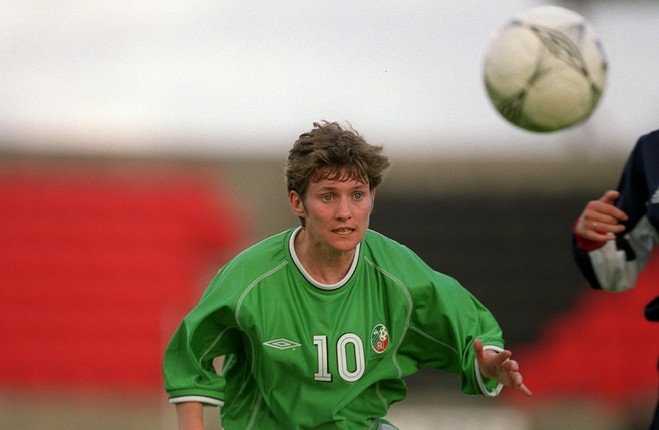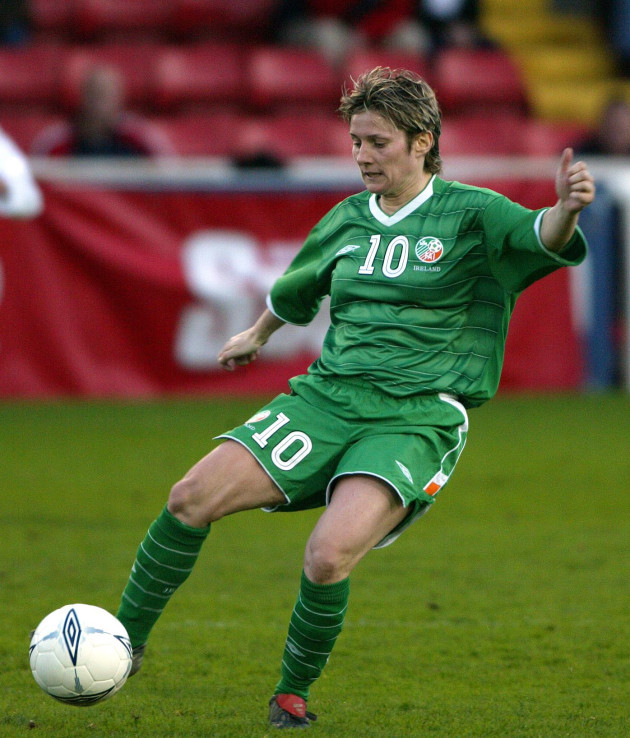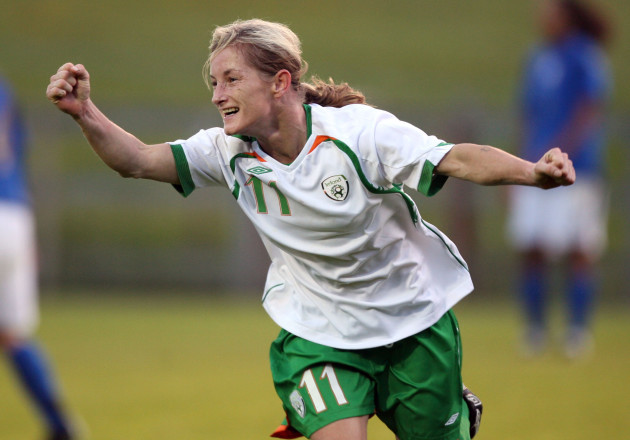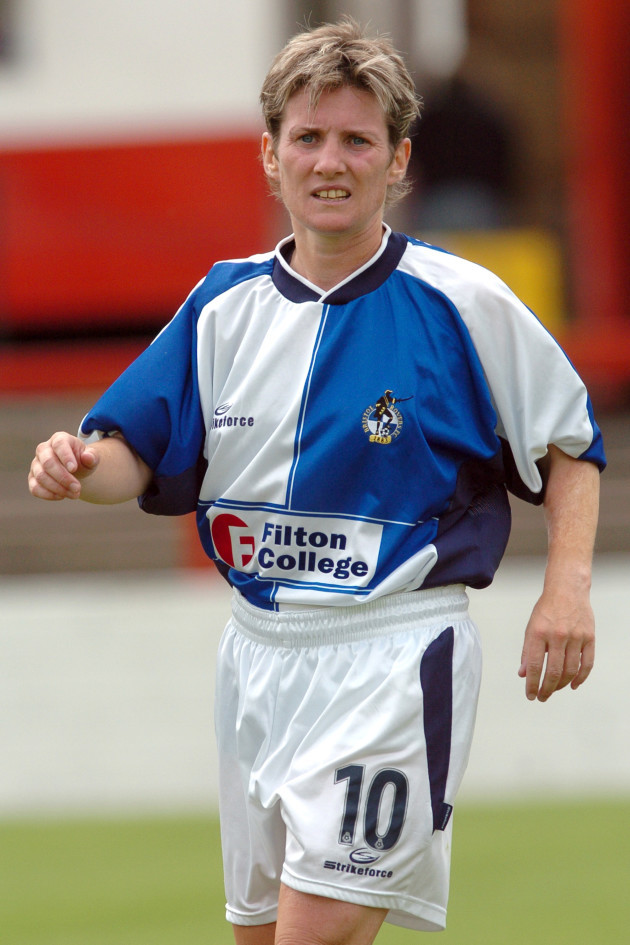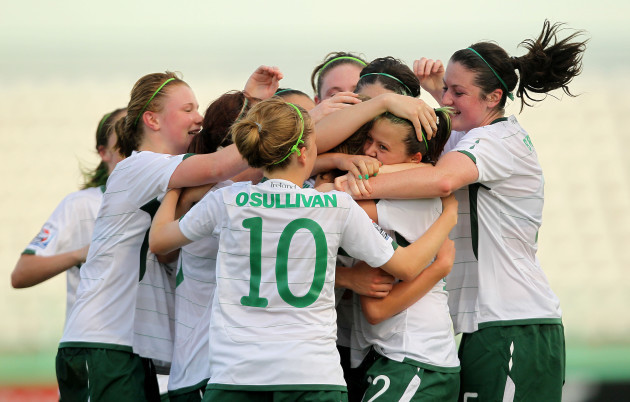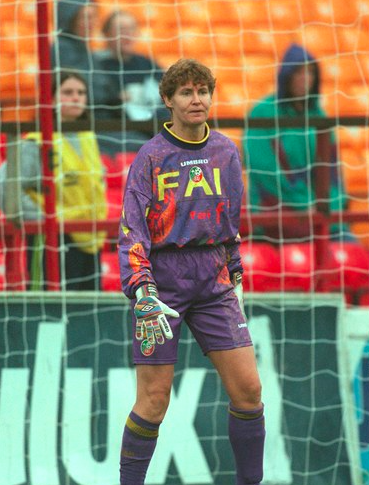IT’S A YEAR of anniversaries for Claire Scanlan, though she needs reminding of that.
Thirty years since her senior debut for the Republic of Ireland, twenty years since being named FAI Women’s Player of the Year, ten years since stepping away after close to 60 caps.
The adventure has had quite a few stops, the latest of which is the University of Albany, about a two-and-a-half-hour drive north of Manhattan, where she’s been for the last two years as associate head coach.
But the story starts in the small, seaside Dublin town of Rush a lifetime ago.
1989
One of the Boys
The decade culminates in you playing for Ireland but what was it like before that?
I wanted to play professional football. I’m a United fan all my life because my Dad gave me a kit for my eighth birthday and that’s how it started. Georgie Best was my favourite player of all time. I was convinced I would play for United. I thought I was going to play for them for years. Then I realised it wasn’t going to happen. I was writing away to clubs to see if they had women’s teams but United didn’t. Then I’d heard Manchester City might but it turned out it was only for younger age-groups.
Rush is such a big part of my upbringing. I had a wonderful teacher in the national school, Eugene Aherne, and as I got a bit older I was able to play for the school team. I was the first girl to score a goal playing hurling at Croke Park. I’d train with the boys and for most of my youth, I was on the green with the boys, either playing hurling or football. I played with the local cricket team so I was in an environment where I didn’t know any better. None of my ‘girls’ from school were playing football. It was just that my brother and my Dad would head out to kick a ball around and I’d join in. And then I started playing with the lads in Kenure Park, where I’m from. You have to start somewhere.
Football was everything. I wanted to be a footballer but didn’t know how that was going to happen. I was playing and training with the Irish team and I’d head into Dublin city centre and we’d meet at the back of Croke Park because there was a small field there. This was back in the days when there were no resources. I’d get the 33 bus into town right after school so you could be at training on time. You’d do your homework when and where you could. Either on the bus there or on the way back.
Was there ever a moment when you felt it was odd playing on a boys’ team?
It was something I never even thought about. I was fairly naive, I guess. All I’d known was playing with boys. I grew up with them. I didn’t think it was strange. I just thought it’s what you do. If you want to play football, you go out and play with whoever is there. And I must admit, it was a great way to grow up and learn the game. Playing with boys will improve you. They’re bigger, stronger, faster. It made me a better player and certainly helped me with my development.
But there were no girls I knew that played. It was only when I signed for Rush Athletic that I saw other females playing football. There was nobody else. When I went to my first Irish training session, I couldn’t believe the level. People from all over the country. Really good female players. So, they were out there. They just weren’t in Rush at that time.
I was still playing out on the green with the boys right up until the end of secondary school and that’s just because I started to train more with the Irish team. So, I was about 16 or 17 when I stopped and moved into senior football.
What was your first experience of the Irish women’s team? Had you seen anything before you were capped?
My parents were very supportive. It probably took my Mother a minute to figure out a girl playing football because it wasn’t a thing at the time. But in ’88, my Dad brought me to an international match. I think it was against Sweden and it happened shortly after getting a call-up to the Under-18s. But the game was at Dalymount and I remembering thinking it was fantastic. A real stadium, a real pitch, a real deal. And getting to play for your country! There’s no better honour. And I had such admiration. I just said, ‘I want to do that’. At one stage, the ball came over to our side. And Grainne O’Malley, a really, really good player, was literally feet away from me. The power, the strength. Watching another female athlete – an elite athlete…I just hadn’t seen it before. I played with my club but this was international level. And it was a big moment for me. I didn’t know there was an international team. It wasn’t posted about anywhere. There was no internet. It was all naive, all very new. Women play football? And they do it at an elite level here in our country? Once I saw it, I wanted to be a part of that.
But what was it like when you realised that because of your gender your professional football dreams were essentially fanciful?
It just became apparent. I remember saying, ‘How am I going to be a footballer if I can’t play with Man United’? Then it was just, ‘Where can I play football? Full-time football?’ And then I heard a little bit in the Ireland camp about going to America. One of my team-mates, Tracy Cross from Limerick, was going to Mercyhurst in Erie, Pennsylvania. We’d chat about it – before Tracy was heading over – and I just thought it was brilliant. And the next year, I ended up going over there too. There was another Irish player in their programme – Noreen Herlihy – so they obviously knew there was a network in Ireland that wasn’t really being tapped into.
And it was such an easy decision for me. There were no academies, no full-time football. This was 1992. I think I even did a FÁS course for a year in the Sheriff Street area just to play football every day. So at the time, all I needed to know was how it worked, when I was going to train, when I was going to play. And the education – the actual degree – wasn’t my swaying factor. Football was. But it became apparent, once I got over there, that the entire experience was going to be a lot of fun.
How grim was the international setup at that time?
It was very amateur. There was no funding, no resources. At weekends, we’d meet somewhere behind the airport. I remember being around Marian Leahy – our captain – who I looked up to so much. A legend. Then there was Martina Colville, Jean Dunne, Sue Hayden. Legends of the game. International stalwarts. I was just a blow-in, a young one coming through. But Marian, who was from Limerick, would talk about staying in one of the administrator’s houses. There were no hotels. The players would be on the couch or a pull-out mattress. So for those guys, it was much rougher because I was in County Dublin at least.
It was just lowly-funded. But I have to admit, I certainly felt appreciative of everything we had. And in awe of the environment I was in. Now, looking back, I’m like, ‘Oh, my goodness. We could’ve done so much better’. But hindsight is always great.
Olivia O’Toole tells some great war stories. There’s one about a hotel in Minsk that she thought rented their rooms by the hour.
I would believe anything Olivia O’Toole says because she’s a legend. She’s the best player that ever came out of Ireland. If structures were better at that time, there’s no telling what kind of star she could have been. A very, very good player and the most technical I’ve ever seen. And such a lovely person on top of that. A great captain and herself and Ciara Grant, another fantastic player and captain. But Olivia had qualities that I don’t think any other player had, in my very humble opinion.
Obviously it’s been talked about before but arriving home into Dublin Airport and having to go into the toilets straightaway and take the tracksuit off…That will never be forgotten because it was just so strange. In the early days, you were given a blazer and had to show up in a navy skirt and black shoes. But that was back in the dark ages. I do remember being in Moldova or somewhere like that and we stayed in a place where the food was so bad. Like, it was inedible. Then there were places without fresh water so we’d have to find ways of getting clean water for our bottles during training and games.
1999
Big in Japan
When you went to Mercyhurst for university, it presumably affected playing for Ireland?
Well, the funding wasn’t there. And there had been players who’d gone to America – and elsewhere – before me and it was the same. And, to be honest, I never really thought I could have been brought back for games. It was a case of sacrificing something in order to make myself better. And I was very happy with the decision. There were very few options for someone who wanted to play at the next level of football. So the college scholarship route made perfect sense and was the right thing to do.
But when I graduated in ’96, it was a case of, ‘Now what? Where can I go and play?’ It took almost a year to get a contract because they weren’t exactly handing them out. There were a few leagues in operation at the time: semi-pro in Germany, semi-pro in Sweden, I don’t think Iceland had a pro league at the time. So there were very few places for female footballers to go. But Japan was one of the options. I thought it would suit me better just because I was smaller and more technical. I thought, ‘I want to play – where can I find success’? I went for a trial in San Jose, California – around late-1996, early-1997 – and fortunately I was offered a position with OKI FC Winds. At the time in Japan, various companies – in our case OKI, who were involved in the printing industry – would sponsor the women’s teams and they’d be allowed three or four international players. I was at OKI on a one-year deal and loved it. There were some other girls who had played for the US – Saskia Webber, a goalkeeper, who was back-up to Briana Scurry at the ’99 World Cup, and Tammy Pearman, a striker. It was totally different but what an experience. The culture, the language. Some of the Japanese players had broken English so the communication happened but it was very broken so there were a lot of giggles in between. We got Japanese lessons once a week which helped but you’d need slightly more to properly pick it. Turns out it’s a pretty tricky language! I thought there was something similar between Japanese and Irish culture. There was a humility to the Japanese and even though they seemed quite distant, they were friendly and lovely. There weren’t a lot of grass pitches – on game day we’d play on one – but for training, it was basically a hardened dirt field. Grass was at a premium, land was at a premium. I felt they were a little behind in terms of coaching, resources, facilities but they obviously came back and won the World Cup in 2011 so they made huge progress along the way.
There was a stint back home once you finished the degree but it seemed like the US always had a pull over you?
I went back and played for Shelbourne for a couple of years but I wanted more. Since I’d gone to college in America, I wanted to get a Masters degree. They have a thing over here called a GA, a graduate assistant. So I went to Troy University in Alabama and while I was there, I’d do my own training, I’d coach and get my Masters while as an assistant with the programme. When I was at Shels, I’d made contact with the Irish squad again and Mick Cooke was in charge. He was nice enough to have me come and train and not long after, Noel King took over. And after I went to the States, I was flown back for Irish games. And in 1999, I got that lovely award from the FAI.
I wrapped up the Masters in 2001 and still felt strong enough and good enough to keep playing. A bunch of countries came to mind but I decided England was a good place to be. A few Irish girls were at Arsenal – Emma (Byrne) and Ciara (Grant), our captain – a great player – so I thought I’d reach out to a few clubs. Leeds United invited me for a trial and I ended up staying for four years. But in 2004, I had an opportunity to coach an academy in Bristol where I’d play for the women’s team while combining the coaching duties and I was there for four years.
In was 2008, I was in my mid-30s and a job opened up at Troy University, where I’d done my Masters. It was a full-time assistant role. I wasn’t looking to make a move but I’d always wanted to be in the college system in America: the environment, the age-group, everything appealed to me.
2009
Have Boots, Will Travel
Though you stepped away from playing, you got the chance to get involved with the women’s international programme. What did that mean to you?
The Irish team were doing a training camp in Indiana. Noel [King] asked if I wanted to be part of the background staff, helping out and just doing what was needed – not so much coaching but picking up the cones, basically. And I’d do anything for my country. Whatever is needed, I’ll do and it was great to see some of the younger players coming through at that stage.
Then, the following year – 2010 – the Irish Under-17s were going to Trinidad and Tobago for the World Cup. And Noel got in touch again and asked if I was available for a month or two in the September. I made sure I was. Fortunately, my bosses at Troy allowed me have that opportunity and I was deeply honoured to have been part of the setup. My former team-mate Sharon Boyle was already there as an assistant and I loved every single second. It was a really successful team with Riana Jarrett, Clare Shine, Denise O’Sullivan – you could see the talent and it’s great to see those players having made the jump to senior level.
In 2014, I made the move to Oakland University in Michigan where I worked with a former Irish player – Mags Saurin. She played for Shamrock Rovers and Ireland and was a left-winger and she’s a fantastic coach. It was like an apprenticeship, really. Mags had progressed in her career and we were fortunate enough to win a conference title which was very nice. And then there was an opportunity to come here to Albany. My wife and I always wanted to be based close to New York so we made the move in 2017 and we’re really happy.
For your entire career – playing and coaching – there’s been constant movement. Wherever there’s been a football-related opportunity, you’ve just gone for it regardless of location.
I’m blessed with the parents I’ve had. My sister is in Australia, my brother is in England and another is in Dublin. And from an early age, I saw people travel. And the sport I’m in, there wasn’t a lot of women’s football around. You had to travel. You needed to be ready to go because otherwise you’d miss opportunities and they might not come around again. From an early age, I realised I had to move. If there was a system back home similar to what there was over here, I’m sure a lot of Irish coaches that have subsequently come over here would be back in Ireland now. But the US has been great in terms of the advancement of women’s football and there’s a reason for that. There’s an entire collegiate system that allows players develop with the resources they need. There’s the coaching and also the performance training, strength and conditioning. Whatever they need, they have it.
2019
Roots
Throughout the conversation, you’ve mentioned the impact and influence of former team-mates. Is it irritating that their contribution to the women’s game in Ireland has largely gone unnoticed?
When you see the US team that won the World Cup in ’99 being recognised a few months ago, it’s a reminder. It’s so important that some of the old guard are remembered. Those players that came before us and who paved the way for so many of us. They had it much harder than we did – the likes of Marion Leahy, Tina Colville, Sue Hayden, Jean Dunne. With each generation you want to see improvement and thankfully it’s happening now. It’s an exciting time and it’s fresh and new. They’re all playing in competitive leagues and everything about the game is where it needs to be but needs to continue to move forward.
I felt sad they had to do it and make that kind of statement to have the most basic equalities for your sport. But I’m fully supportive of what they did. You think back to years ago and it certainly wouldn’t have crossed our minds – certainly not mine. But times were different. I don’t even know if the money was available. But they had to take that stance. And there’s no other way to show your displeasure other than protesting. I’m glad it’s come to this. Any young player should be very excited. The players plying their trade full-time and that’s what you need.
I think back to my day and how many girls around the country that may have been really good footballers but never got spotted, never had an opportunity and then moved on and lived their lives without playing football. But there are different avenues now and there’s a good chance that if you’re a good player that you will get a chance. There’s more opportunity to find that pathway.
Manchester United now have a women’s team. Maybe there could be another stop on the journey and you can live out your childhood dream?
It’s probably 30 years too late, isn’t it? I’m getting to the settling down phase now. I’ve done the travelling and I’m alright putting roots down. I’d be okay to visit and watch them play.
But I can’t complain with the career I’ve had – I’ve loved every minute. I’ve learned from it all – the good and the bad. I’ve met some great people, great players, great coaches. But we’re still a United household, even the dog. My wife is American, a Californian. Over here, a lot of women have played football in college so she’d been around that and it wasn’t too surprising for her to hear it’s what I did. But I think the level I’d played at was probably a surprise to her.
We’re about two-and-a-half-hours north of New York. I’m an associate head coach here at Albany and we’re very happy. I believe in a good work environment and good people around me and I’ve been fortunate to have that. We’re here for the foreseeable future. One never knows but sooner rather than later we’ll really set down some roots. I’m ready to stop moving now. I want to play with the dog in the back yard and that’s that.
The42 is on Instagram! Tap the button below on your phone to follow us!
